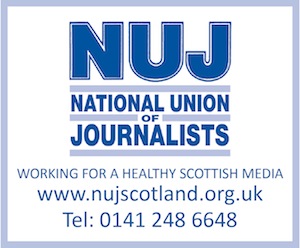JOHN MacKay is the news anchor on the STV News at Six and presents STV’s evening current affairs programme, Scotland Tonight. He began his career at The Sunday Post after graduating from Glasgow University. From there he moved to BBC Radio Scotland as a news trainee. At the BBC, he worked for seven years across a range of roles, from subbing to producing to reporting and presenting on both radio and television.
He joined STV as a reporter/presenter in 1994, becoming a permanent part of the presentation team four years later. He became the sole anchor when STV moved to Pacific Quay in 2006.
He has covered most of the major stories in Scotland in recent times, including the creation of the Scottish Parliament, the Dunblane Shootings and the G8 Summit.
He submitted this on Wednesday, August 29.
What exactly is it you do?
I present the main STV News at Six O’Clock from Monday to Friday and the lunchtime bulletins. I present STV’s new current affairs programme, Scotland Tonight, at 2230 on Mondays and Tuesdays.
What did your working day today or yesterday comprise?
Yesterday, I arrived at the newsroom for the 1300 editorial meeting. This is an update on how the news day is progressing and we discuss the treatment of stories we are covering, consider other stories that may be breaking and the order of the evening bulletin at Six O’Clock. This can change constantly throughout the day, even when we are on air.
From there, I prepare for the lunchtime bulletin, at 1355, checking the running order and scripts. A regular question for presenters is, “Do you write your own scripts?” Typically, the reporter will file their intro, I will check it and make any changes – factual or stylistic – if necessary and the producer has the final say. That is the protocol, but it’s rarely as structured as that and is usually more of a team effort. Sometimes, I am reading scripts blind because they have been filed very late. That used to be far more common, but the laptop I use allows me to see changes almost as they happen.
After the lunchtime bulletin, it’s straight into the Scotland Tonight production meeting where we thrash out ideas for that night’s programme. We have a small team and everyone chips in. Sometimes the subjects are obvious, but other times we have to be more creative. It’s not just the subject, though, we have to consider what guests will make for interesting television. Those who criticise TV for using familiar guests betray a lack of understanding of how difficult it can be. That will last until about 1500.
I read up on the subjects we’ve discussed, keeping an eye on the news wires and dealing with emails and admin.
From 1600, it is a blur of activity as the programme comes together for transmission. I also have to write and record promos for both the News and Scotland Tonight with the clothes changes that requires.
The Scotland Tonight look tends to be darker and less formal. I’m in the studio about 1745 to record another promo and do a script check. However, even then it can often change. Last night, a planned live-on-location had to be abandoned as we went on air because high winds were making the signal unstable. The programme broadcast bore little resemblance to the running order we went with into the studio. It’s part of the buzz of live broadcasting.
There is usually an informal debrief of the News and then I begin preparing for Scotland Tonight, usually grabbing a bite at my desk while reading up on notes. Often, the programme in place when I go into the studio for the News is transformed by the time I re-emerge. Stories change or guests aren’t available. We have a production meeting at 2000. The team will have spoken to the guests and we have an idea of what we expect them to say.
Guests will often tone it down considerably by the time they come on air, whether because of nerves or concern about how they will come across. Part of my role is to draw it out of them. I will structure some questions, but they are only a guide. Discussions often take on a life of their own and it’s good to go with that, sometimes opening up whole new areas of interest. We also make a point of using social networks, Twitter especially, to allow viewers to be part of the debate. Again, that can change the course of the interviews.
By 2100, we are doing a run through of the programme in the studio. Sometimes we will have had to do a pre-record to suit a guest or because of the availability of a remote studio.
The guests arrive around 2200 and I have a quick chat with them to outline the areas we would like to cover. We rarely get through it all. I try to put new guests at their ease, and we do make a point of introducing new faces to the debate.
We go on air at 2230 and the programme zips along. Guests frequently comment on how quickly it passes for them and how much they enjoy the relaxed approach.
By 2300, we gather in the Green Room to enjoy a bowl of the finest crisps and a drink, be it tea or wine. We often think a camera in the Green Room would make for great TV because the conversation can be candid and fascinating, although possibly it would not pass the lawyers.
How different or similar was it to your average working day?
That is very typical of the days I’m doing Scotland Tonight. On the days my colleague, Rona Dougall, is doing it, the News is my sole focus.
How different or similar was it to your average working day when you started in post?
It’s a different world from when I started in journalism. Then, it was manual typewriters, carbon paper and hot metal printing.
Technology has wrought huge changes since I came into broadcasting. Mobile phones, satellite facilities, desktop editing, even the the number of outlets have transformed the way we report the news.
How do you see the job evolving?
It will continue to change in the way it always has. Technology will dictate the way we report the news and the range of platforms will change the way we deliver it. Despite the demise of broadcast news being predicted for a long time, I think there will continue to be demand for a well-produced digest of news at the end of the day.
The STV News audience is evidence of that. And for all that the last General Election was predicted to be decided online, it was actually broadcast events that counted.
What gives you most job satisfaction?
The director’s voice in my ear saying, “…and off air. Good programme everyone.”






